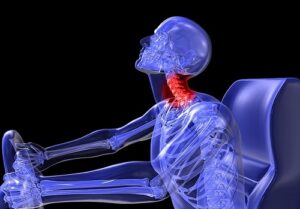
Whiplash in Singapore is the result of the neck muscles experiencing strain because of a fast backward and forward movement. This abrupt motion leads to the stretching and tearing of the tendons and ligaments in the neck, resulting in injuries related to whiplash caused by a motor vehicle accident.
Neck injuries, also known as cervical spine injuries, differ in intensity and kind. An injury to your neck may have come before by accident, trauma to the area falls, degenerative changes that happen in the spine, or a mix.
An overview of one of the most typical types plus details on their signs and treatment can be seen below.
Neck Injuries Affecting Soft Tissue
Damage to one anatomical part of your neck commonly suggests damage to others. This is because the parts of your neck are connected.
The bones, joints, muscles, and nerves in the neck work jointly to support and help with the movement of your head. For instance, whiplash can bring about numerous medical diagnoses such as muscle tension, ligament strain, or damage to the spinal discs.
The bright side is that a lot of the time, neck injuries generally affect soft tissue, muscles, tendons, ligaments, and/or fascia. But every sort of cervical spine injury, including those that include the bones, joints, and discs, will additionally affect your muscles at the very least somewhat.
Neck Injuries That May Affect Nerves and/or the Spinal Cord
Particular neck injuries have an impact on the nerves and can be rather severe. Generally, nerve difficulties occur when a spinal framework makes contact with or uses pressure on a spinal nerve origin, the spinal cord, or both.
The continuing injury descriptions in this article discuss those that somehow, whether mild or severe, affect some element of the nerves.
Strained Muscles
A neck strain is an injury to the muscles that connect to and relocate the head and top part of the spine. Signs consist of muscle spasms, lowered versatility, and pain.
Pressures are rated, implying that they range from mild to extreme.
Light stress of Grade I can be taken care of by adjusting activity degrees to a point where the pain is acceptable, without needing to be totally bedridden. Furthermore, using over-the-counter pain alleviation medication is a preferred technique to ease the pain triggered by a mild strain. If the pain continues for more than a week or substantially impacts your day-to-day regimen, it is suggested to consult a doctor, similar to managing a neck crick.
If you have a Grade II neck strain, the muscle is the only part that is injured. Comparable to a Grade 1 strain, the pain in your neck is unlikely to be an indicator of any other type of damage to the structure.
Yet when it involves Grades III and IV, it is. According to the Quebec Task Force on Whiplash-Associated Disorders, Grade III neck strain is connected with nerve damage. In this situation, you may, among other things, get weak and/or feel electrical experiences down one arm. With these injuries, making an appointment with your physician ASAP will likely provide you with the very best possibility of a full recovery especially when surgery may be needed.
Needless to say, Grade IV neck pressures or whiplash are one of the most significant of all. The Quebec Task Force claims these relate to fracture or vertebral dislocation. This injury needs prompt medical attention.
Sprained Neck
Strains are injuries to ligaments. (Ligaments are strong bands of connective tissue that hold bones together.)
Autumns or sudden turnings that strain or stretch one or multiple joints in the cervical spine can lead to neck strains. Additionally, a regular resource of neck strains is the recurring pressure on the joint.
According to the American Academy of Orthopaedic Surgeons, symptoms of a neck strain can be extremely varied but may consist of pain at the back of your neck that worsens when you relocate, pain that begins slowly and peaks after concerning 24 hour hours, migraine at the back of the neck, muscles spasms and pain in your upper shoulder, neck tightness, and/or pins and needles, weakness, or tingling in your arm.
Neck sprains can likewise bring on less architectural type signs, including a sore throat, mood modifications, problem focusing or resting, and extra, the AAOS says. Comparable to neck strains, neck strains can be light, modest, or severe and are rated. This may suggest, for example, that if you have prickling down one arm, your strain is a Grade III. Always check with your medical professional to make sure especially if you have neck pain.
For minor and moderate sprains, usually relaxing and icing the location is recommended, as is taking anti-inflammatory medication. Typically an over-the-counter will certainly do. Getting it inspected by a physician is essential, as well.
Injuries Linked to Whiplash (WAD)
Whiplash (WAD) is a collection of signs and symptoms adhering to an activity occasion in which the head is thrown initially into hyperextension and after that rapidly forward right into flexion. It’s frequently a result of car crashes, yet may be caused by sports injuries, falls, or injury.
Like a neck crick, WAD is not a medical diagnosis. It’s an episode that can lead to any type variety of diagnoses from strain to a herniated disc and in some cases much more. Whiplash may damage joints or discs, which in turn may aggravate spinal nerve origins or, more rarely, the spine, creating nerve signs.
Signs and symptoms arising from the injury can vary depending on its details and qualities. These symptoms may incorporate discomfort, weak points, pins and needles, tingling, or other feelings similar to electric shocks that take a trip down one arm. Furthermore, stiffness, lightheadedness, or interrupted sleep might additionally take place. It is essential to keep in mind that signs and symptoms might potentially be experienced with a hold-up of one or two days after the whiplash occurrence.
Whiplash injuries can differ in their severity, ranging from very little pain and limited neck activity to complete resolution within a couple of weeks without any long-term problems.
The Quebec Task Force (QTF) includes a category of the various qualities of whiplash-associated problems in terms of severity. The awards under each grade will certainly bring various awards of damages. The category is generally classified as complies with.
- Grade 0 represents people who do not experience any neck discomfort or rigidity. Grade 1 suggests individuals who just have complaints of discomfort, stiffness, or tenderness in the neck however do disappoint any type of physical indications. Grade 2 represents individuals with neck issues where the doctor observes a decreased range of activity and inflammation in the neck.
- Grade 3 indicates individuals with neck problems and additional neurological signs such as decreased or absent deep ligament reflexes, weakness, or sensory deficits. Grade 4 represents individuals with neck grievances who have experienced a fracture, dislocation, or injury to the spinal cord. A herniated disc refers to a problem where the cushion-like discs in between the spinal bones become harmed and protrude.
Herniated Disc
A herniated disc happens when the soft compound that is normally included within the disc (called the nucleus pulposus) leaves.
When this jelly-like substance comes down on a nerve root, which it usually does, you’ll likely really feel discomfort and/or have nerve-related symptoms. Nerve-related signs generally consist of weakness, numbness, a burning experience, or an electrical shock sensation that goes down one arm.
Rips in the challenging external fibers of the disc (called annular tears) may result in a herniation. Annular rips might be induced by either duplicated or an unexpected, powerful anxiety to the spinal joint. Treatment normally starts with medicine and physical treatment, however might proceed to surgical procedures as needed.
Herniated discs can occur anywhere along the spine where the shock-absorbing cushions are located, including, in the cervical spine, or neck, location.
Neck Fracture
A fracture in the neck describes a cervical bone being damaged. This can take place because of numerous factors such as injury, dropping, or degenerative spine problems. The kind and severity of the fracture are usually influenced by the angle of the force at the time of influence.
There is a significant danger of cervical fractures for football players who use their heads to obstruct. Older people with osteoporosis are also vulnerable to this threat because of their delicate bones. Normally, severe neck cracks are accompanied by a misplacement.
Therapy relies on a lot of points, including your age, various other medical conditions, and the level of damage to your spine. If a fracture undercuts your neck, you might need to use a halo support.
Spinal Cord Injury
When the spine is harmed due to a neck injury such as a fracture or misplacement, it results in a spinal cord injury (SCI). If the damage occurs at or over the 3rd cervical vertebra, the individual may either shed their life or need a respirator to endure.
Individuals who have spinal cord injuries usually experience a permanent handicap that leads to either total or partial paralysis below the location of the injury.
The timeliness of emergency treatment and the kind of first aid and medical treatment promptly given is particularly important to survival and succeeding lifestyle complying with any serious neck injury.
The honors created for each sort of injury will certainly depend on the intensity and special needs and suffering one experiences.
Can I Claim Compensation For Whiplash?
You will need to be assessed by a medical and legal professional for a claim if the accident is caused by another driver.
